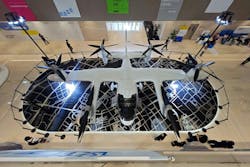FAA requests information on integrating uncrewed aircraft systems
WASHINGTON - The Unmanned Aircraft Systems (UAS) Integration Office of the Federal Aviation Administration (FAA) has issued a request for information (RFI) to gather input from industry stakeholders on research areas that may aid the integration of new aviation technologies, such as UAS and advanced air mobility (AAM), into the National Airspace System (NAS).
The RFI seeks feedback from industry on various research focus areas that could support future standards and technology development for safely integrating new airspace entrants. The FAA may request further information from respondents at its discretion, but participation is for informational purposes only.
FAA officials say that research is central to creating effective policies, regulations, and procedures for new entrants like UAS/AAM vehicles. Ongoing research will help the FAA develop a framework for assessing and integrating these new technologies, enabling strategic planning and data-driven decision-making for future rulemaking, policy, certification, and operational considerations.
Related: Stakeholders commend drone, AAM measures in FAA reauthorization bill
The RFI requests feedback on whether the identified research areas are sufficient to address anticipated business and operational cases for new entrants in the NAS. The areas of focus include several critical domains. First, the FAA is interested in the potential of beyond visual-line-of-sight (BVLOS) operations. This is followed by exploring command and control link technologies, which ensure reliable communication between operators and unmanned vehicles.
Traffic management systems are another key area, with a particular focus on UAS traffic management and advancements in air traffic management. Research into noise and societal impacts is also necessary, as is the development of industry standards to guide technology interoperability, specifically in vehicle-to-vehicle communication, aircraft-to-everything communication, and detect-and-avoid capabilities.
Collision risks among vehicles of various sizes and speeds traveling within shared airspace are also under consideration, as are electronic conspicuity technologies that improve the visibility of unmanned aircraft. Human factors are another research priority, covering aspects such as the human-system interface, operational procedures, and the qualifications of pilots and crew.
Related: FAA issues final rule for pilot training and certification of powered-lift aircraft
The FAA also highlights advanced automation, including applications of artificial intelligence and machine learning, as essential for new entrant operations. Infrastructure requirements, including potential needs for airports, droneports, and vertiports, are necessary to support these evolving technologies. Lastly, the risks posed by hazardous materials aboard UAS, whether as cargo or power sources, are also flagged for research and analysis.
Responses to this RFI are due via email by 3:00 PM EST on 2 December 2024. Responses should be emailed to the FAA Contracting Officer Karina Espinosa at [email protected], and Kristin Frantz at [email protected]. More information and documentation is available at https://sam.gov/opp/5275b3a9a680427e9b66b6c0650e5073/view.
About the Author

Jamie Whitney
Jamie Whitney joined the staff of Military & Aerospace Electronics and Intelligent Aerospace. He brings seven years of print newspaper experience to the aerospace and defense electronics industry.
Whitney oversees editorial content for the Intelligent Aerospace Website, as well as produce news and features for Military & Aerospace Electronics, attend industry events, produce Webcasts, oversee print production of Military & Aerospace Electronics, and expand the Intelligent Aerospace and Military & Aerospace Electronics franchises with new and innovative content.
